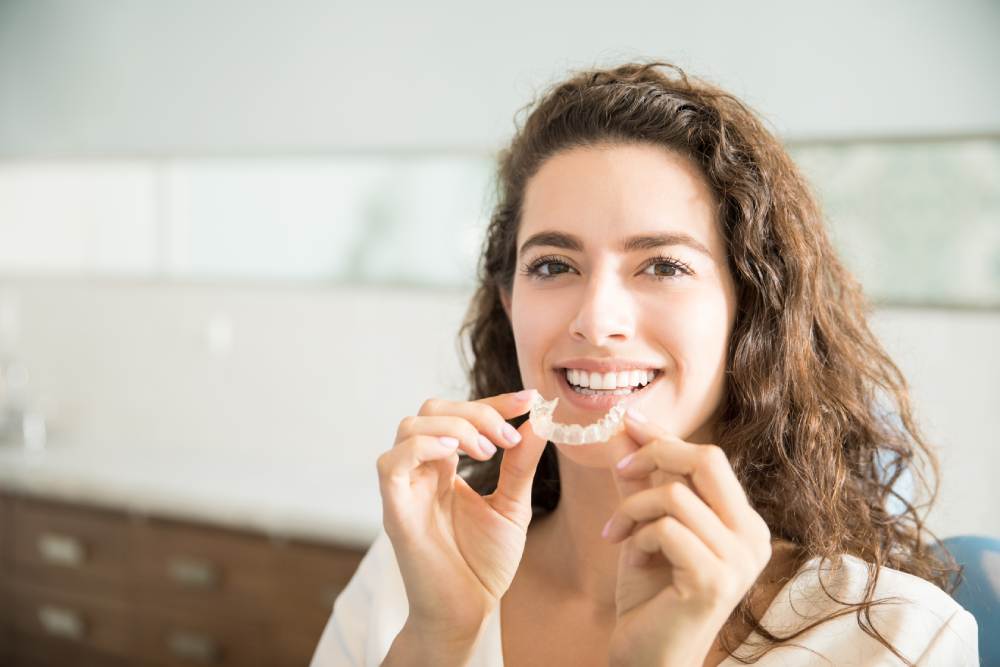How long should you wear each Invisalign aligner to get the best results? You might think it’s as simple as switching trays every few weeks, but there’s more to it than meets the eye. In this article, we’ll explore the critical factors that determine the ideal wear time for your aligners—and why sticking to the right schedule could make or break your treatment success. Curious? Let’s dive in!
Schedule your invisalign Manhattan consultation today!

What Is the Recommended Duration for Each Invisalign Aligner?
One of the main recommendations from orthodontists is to wear each Invisalign aligner for 20 to 22 hours daily. This time allows the teeth to progressively move into the correct position according to the personalized treatment plan designed for each patient.
Not following this schedule can delay results since dental movements need constant pressure to be effective. Remember, aligners should only be removed to:
- Eat
- Drink (anything other than water)
- Perform oral hygiene.
Wearing the aligners most of the day is essential, and it’s also important to understand why this is recommended.
Teeth move gradually under the forces applied by the aligners. If worn less than the recommended time, the teeth won’t shift properly, which could lead to unwanted adjustments and extend the treatment.
Each aligner applies precise pressure to specific teeth, facilitating sequential movement. The system is designed to move certain teeth at each stage, so every aligner is critical for overall success.
What Is the Recommended Schedule for Changing Aligners?
The recommended schedule for changing aligners depends on multiple factors, like case complexity and individual response to treatment. Generally, the standard is to change aligners every 1 or 2 weeks. This period allows the teeth to adapt to the movements each aligner is designed to produce.
The reason aligners need to be changed every one to two weeks is due to the treatment design itself. Each Invisalign aligner is custom-made to cause a tooth shift of approximately 0.25 mm. During the time the aligner is worn, the teeth experience a slight movement that, after several weeks and aligner changes, results in significant alignment.
| Number of weeks | Total Movement (mm) | Number of aligners |
| 2 weeks | 0.25 mm | 1 |
| 4 weeks | 0.50 mm | 2 |
| 8 weeks | 1 mm | 4 |
Changing aligners earlier or later than recommended can affect treatment success.
- Too early, and the teeth may not adjust fully, causing discomfort and hindering proper movement. Too late, and the treatment might be prolonged.
- Regular check-ups with your orthodontist will monitor progress to ensure everything moves as planned. In some cases, adjustments to the schedule may be necessary.
Factors That Influence Aligner Wear Time
The time each patient needs to wear their Invisalign aligners can vary. Several factors influence this, including:
- Patient discipline: Wearing the aligners for at least 20, ideally 22, hours daily is crucial for treatment success. If this isn’t followed, results will be compromised, potentially lengthening the overall treatment time.
- Case complexity: More complex dental issues, like deep bites, crossbites, or significant tooth shifts, might require a longer use of aligners or treatment plan adjustments.
- Additional adjustments: Sometimes, teeth may not move as expected, requiring refinements, which can extend treatment time. These adjustments are common and part of the personalized Invisalign process.
- External factors: Stress, dental health, and even diet can impact the treatment duration. For instance, untreated cavities or gum problems can slow progress.
Tips for Proper Use of Your Invisalign Aligners
To get the best results with Invisalign, it is essential to follow certain wear guidelines that will ensure that treatment progresses as planned. Here are some tips to maximize the effectiveness of your aligners:
- Wear your aligners as recommended: For effective treatment, wear the aligners for at least 20 hours a day, ideally 22. Remove them only for eating and oral hygiene.
- Maintain oral hygiene: Every time you remove your aligners for a meal, brush your teeth before putting them back in. Poor oral hygiene can lead to plaque buildup or cavities during treatment.
- Use dental floss: Floss daily to ensure no food particles remain between your teeth, which could interfere with the aligners fitting correctly and teeth movement.
- Use chewies: Biting on chewies for 10 to 30 minutes daily can help ensure the aligners fit properly and exert the right amount of pressure where needed.
- Follow the change schedule: Sticking to the aligner change schedule helps ensure that your treatment progresses smoothly, reducing the risk of extending the process.
- Regular orthodontist visits: Regular check-ups are key to monitoring treatment progress and making any necessary adjustments to your plan.
Invisalign treatment success relies on patient discipline, following the aligner change schedule, and the complexity of the case.
Achieve Your Ideal Smile with Invisalign
With proper aligner use and following your orthodontist’s recommendations, patients can achieve effective and discreet dental alignment. The comfort, aesthetics, and ease of use that Invisalign offers make it a great option for those looking for a modern alternative to traditional orthodontics.
Remember, personal commitment is essential to achieving the desired results. If you have any questions about your treatment, consult your orthodontist, who can adjust and personalize the plan as needed. Invisalign provides a more comfortable and aesthetically pleasing experience, delivering a straighter smile compared to other treatments.
Sources:
- Moshiri, M. (2021). Product review and demonstration of the Invisalign clear aligner system.
- Alajmi, S., Shaban, A., & Al-Azemi, R. (2020). Comparison of short-term oral impacts experienced by patients treated with Invisalign or conventional fixed orthodontic appliances. Medical Principles and Practice, 29(4), 382-388.
